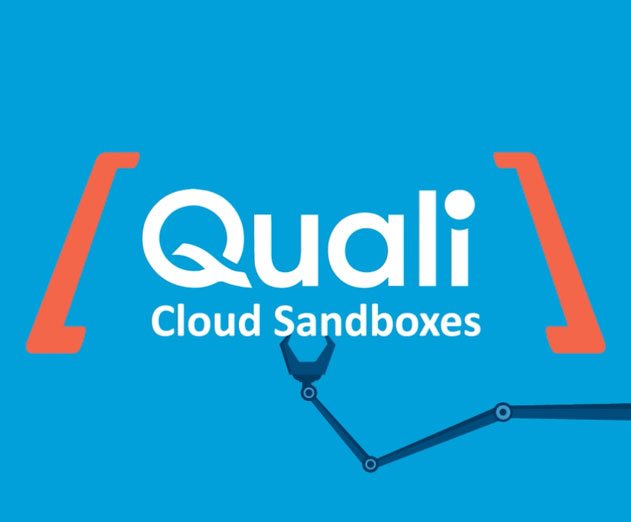A discussion on cloud sandboxes with Quali's CMO Shashi Kiran
Monday, October 17, 2016

|
Richard Harris |
DevOps processes are used to accelerate the development of cloud applications, and sandboxes can help by providing actual replicas of production environments for developers to try out new code, or for test teams to get access to holistic real-world environments without the risk of harming a live production environment.
We recently had an interesting conversation with Shashi Kiran, Chief Marketing Officer at Quali, to discuss how sandboxes can be used to improve DevOps automation.
Kiran: Sandboxes are self-contained infrastructure environments that can be configured to exactly mimic the final live deployment environment. Think of them as containers, but more flexible as they can model infrastructure and applications. Cloud sandboxes enable each software developer and tester to have their own personal replica of the production infrastructure environment, from physical and virtual machines and networks to applications and cloud interfaces.
DevTest and Ops can deploy cloud sandboxes to build and test new applications, stage them and then just take down the virtual sandbox environment when the task is completed. This allows releases to move faster while decreasing risk, cost and complexity. ITOps teams also get the benefit of ensuring smooth governance as they can create blueprints of these environments, set usage policies and derive business and operational metrics.
Kiran: Sandboxes can be an integral tool in a DevOps strategy for continuous iteration, encompassing the CI/CD phases as we know. We often refer this to as the CI/CT/CD phase, to ensure that continuous testing is no tan afterthought. Continuous iteration today has some challenges. These include fragmented toolsets, elongation of test cycles, lack of end-to-end automation, etc. The result is that only about 17% of IT organizations can call themselves high-performing and keep pace with business needs.
By being able to invoke sandboxes in different stages of the CI/CD lifecycle and offering up standardized environments, the automation becomes much easier. Then it is a question of choosing the right deployment path – whether it be into a container, a private cloud or a public cloud environment. Continuous sandboxes allow users to discover which settings or configurations would cause the software to break when it goes into live production,without any of the associated downtime or costs. This can drastically reduce re-work required by 30-40%, improving productivity.
Kiran: Quali’s philosophy is to non-disruptively integrate into your existing tool chain. We have established plug-ins with several tools. Jenkins is a great tool and their pipeline process is well known. Quali cloud sandboxes seamlessly integrate into this pipeline process as described in this solution brief here.
For example, the Quali Jenkins Plugin allows DevOps teams to control Quali CloudShell sandboxes directly from the Jenkins pipeline via REST APIs. The open source plugin associates Jenkins or CloudBees jobs with Quali sandboxes, providing the power to run jobs on full-stack sandbox environments, rather than just on simple nodes. This gives users the ability to enable the automated setup and tear down of production-like environments throughout the application release process, rapidly accelerating release cycles while increasing quality.

Kiran: With the pace of change increasing, the engineering leaders are being increasingly asked to manage change and to do more with less. So they are challenged to move fast, while looking at resource efficiency and utilization. Empowering developers and testers is therefore extremely important to minimize hurdles for innovation. These innovators can leverage the power of cloud sandboxes consumed-as-a-service during the Dev/Test/Staging and even production phases to model complex environments, evaluate dependencies and better understand how new apps will impact the infrastructure, including identifying where any network breakdowns may occur.
By combining cloud sandboxes with tools for automation,security testing can be built directly into the automation loop to enable continuous deployment. This level of security is necessary for DevOps to succeed, especially in such highly regulated industries as banking, financial services and healthcare.
Kiran: Quali’s community, which is accessible through our website, is a great way for developers to come and engage with us. We have SDKs they can download and start using. We have over 300 customers pursuing different use-cases. An excellent example of a customer that has used Quali CloudShell to foster a developer community is Cisco with their DevNet offering.
Cisco DevNet is a comprehensive development platform that provides the software code and resources for developers to build innovative network-enabled solutions. DevNet includes broad software toolsets for cloud, networking,data center, collaboration, security, services, and the Internet of Things. Taken together, the DevNet ecosystem gives developers a complete software platform for next-generation services. Developers in the Cisco community can interface through Quali’s Cloudshell UI platform to access the DevNet coding sandbox and related development tools.
Editors note: Shashi Kiran is currently the Chief Marketing Officer at Quali, the leader in cloud sandboxes for DevOps and BizOps automation. He has20+ years of experience in the global marketing, sales engineering and business development teams in the areas of internet working, cloud computing, high performance computing solutions and security. He has held executive leadership positions in large multi-national corporations and well as in venture-backed startups, including a 9-year stint at Cisco where he was most recently head of worldwide marketing for Data center and Cloud networking. Shashi also advises merging startups in the bay area as well as in India on messaging and go-to-market strategies. He is an avid blogger and frequently blogs on technology topics, leadership and life in general.
ADM: What is the purpose of cloud sandboxes and how can they help developers?
Kiran: Sandboxes are self-contained infrastructure environments that can be configured to exactly mimic the final live deployment environment. Think of them as containers, but more flexible as they can model infrastructure and applications. Cloud sandboxes enable each software developer and tester to have their own personal replica of the production infrastructure environment, from physical and virtual machines and networks to applications and cloud interfaces.
DevTest and Ops can deploy cloud sandboxes to build and test new applications, stage them and then just take down the virtual sandbox environment when the task is completed. This allows releases to move faster while decreasing risk, cost and complexity. ITOps teams also get the benefit of ensuring smooth governance as they can create blueprints of these environments, set usage policies and derive business and operational metrics.
ADM: How are cloud sandboxes useful for continuous integration and DevOps practices?
Kiran: Sandboxes can be an integral tool in a DevOps strategy for continuous iteration, encompassing the CI/CD phases as we know. We often refer this to as the CI/CT/CD phase, to ensure that continuous testing is no tan afterthought. Continuous iteration today has some challenges. These include fragmented toolsets, elongation of test cycles, lack of end-to-end automation, etc. The result is that only about 17% of IT organizations can call themselves high-performing and keep pace with business needs.
By being able to invoke sandboxes in different stages of the CI/CD lifecycle and offering up standardized environments, the automation becomes much easier. Then it is a question of choosing the right deployment path – whether it be into a container, a private cloud or a public cloud environment. Continuous sandboxes allow users to discover which settings or configurations would cause the software to break when it goes into live production,without any of the associated downtime or costs. This can drastically reduce re-work required by 30-40%, improving productivity.
ADM: How does a Quali cloud sandbox work in conjunction with test lab tools for building applications such as Jenkins?
Kiran: Quali’s philosophy is to non-disruptively integrate into your existing tool chain. We have established plug-ins with several tools. Jenkins is a great tool and their pipeline process is well known. Quali cloud sandboxes seamlessly integrate into this pipeline process as described in this solution brief here.
For example, the Quali Jenkins Plugin allows DevOps teams to control Quali CloudShell sandboxes directly from the Jenkins pipeline via REST APIs. The open source plugin associates Jenkins or CloudBees jobs with Quali sandboxes, providing the power to run jobs on full-stack sandbox environments, rather than just on simple nodes. This gives users the ability to enable the automated setup and tear down of production-like environments throughout the application release process, rapidly accelerating release cycles while increasing quality.

ADM: What are the benefits for engineering leaders for combining sandbox environments with tools for application release automation?
Kiran: With the pace of change increasing, the engineering leaders are being increasingly asked to manage change and to do more with less. So they are challenged to move fast, while looking at resource efficiency and utilization. Empowering developers and testers is therefore extremely important to minimize hurdles for innovation. These innovators can leverage the power of cloud sandboxes consumed-as-a-service during the Dev/Test/Staging and even production phases to model complex environments, evaluate dependencies and better understand how new apps will impact the infrastructure, including identifying where any network breakdowns may occur.
By combining cloud sandboxes with tools for automation,security testing can be built directly into the automation loop to enable continuous deployment. This level of security is necessary for DevOps to succeed, especially in such highly regulated industries as banking, financial services and healthcare.
ADM: Can you give us an example of a real-world use case of Quali’s CloudShell sandbox technology to create a developer cloud?
Kiran: Quali’s community, which is accessible through our website, is a great way for developers to come and engage with us. We have SDKs they can download and start using. We have over 300 customers pursuing different use-cases. An excellent example of a customer that has used Quali CloudShell to foster a developer community is Cisco with their DevNet offering.
Cisco DevNet is a comprehensive development platform that provides the software code and resources for developers to build innovative network-enabled solutions. DevNet includes broad software toolsets for cloud, networking,data center, collaboration, security, services, and the Internet of Things. Taken together, the DevNet ecosystem gives developers a complete software platform for next-generation services. Developers in the Cisco community can interface through Quali’s Cloudshell UI platform to access the DevNet coding sandbox and related development tools.
Editors note: Shashi Kiran is currently the Chief Marketing Officer at Quali, the leader in cloud sandboxes for DevOps and BizOps automation. He has20+ years of experience in the global marketing, sales engineering and business development teams in the areas of internet working, cloud computing, high performance computing solutions and security. He has held executive leadership positions in large multi-national corporations and well as in venture-backed startups, including a 9-year stint at Cisco where he was most recently head of worldwide marketing for Data center and Cloud networking. Shashi also advises merging startups in the bay area as well as in India on messaging and go-to-market strategies. He is an avid blogger and frequently blogs on technology topics, leadership and life in general.
Read more: http://quali.com

Become a subscriber of App Developer Magazine for just $5.99 a month and take advantage of all these perks.
MEMBERS GET ACCESS TO
- - Exclusive content from leaders in the industry
- - Q&A articles from industry leaders
- - Tips and tricks from the most successful developers weekly
- - Monthly issues, including all 90+ back-issues since 2012
- - Event discounts and early-bird signups
- - Gain insight from top achievers in the app store
- - Learn what tools to use, what SDK's to use, and more
Subscribe here











